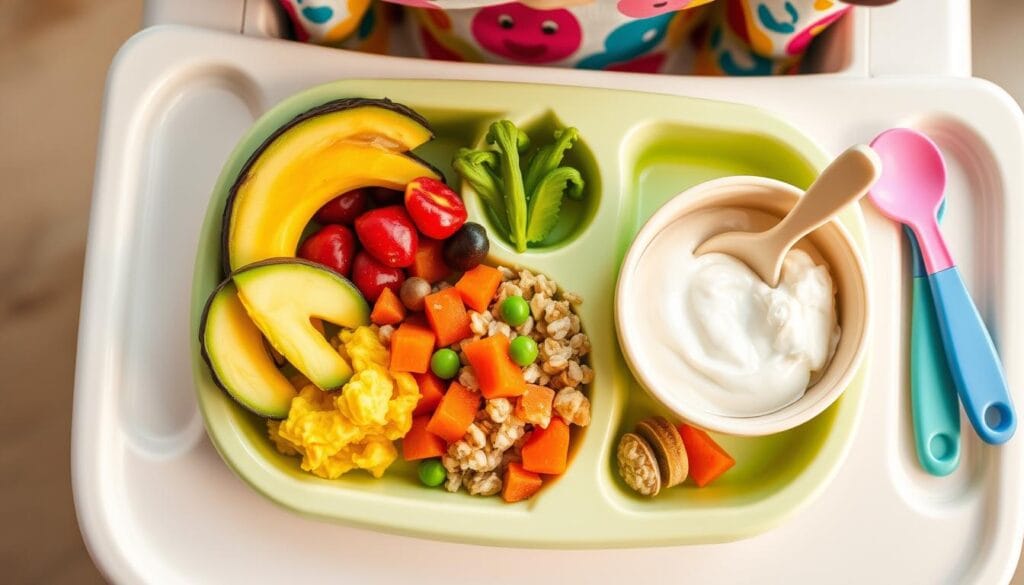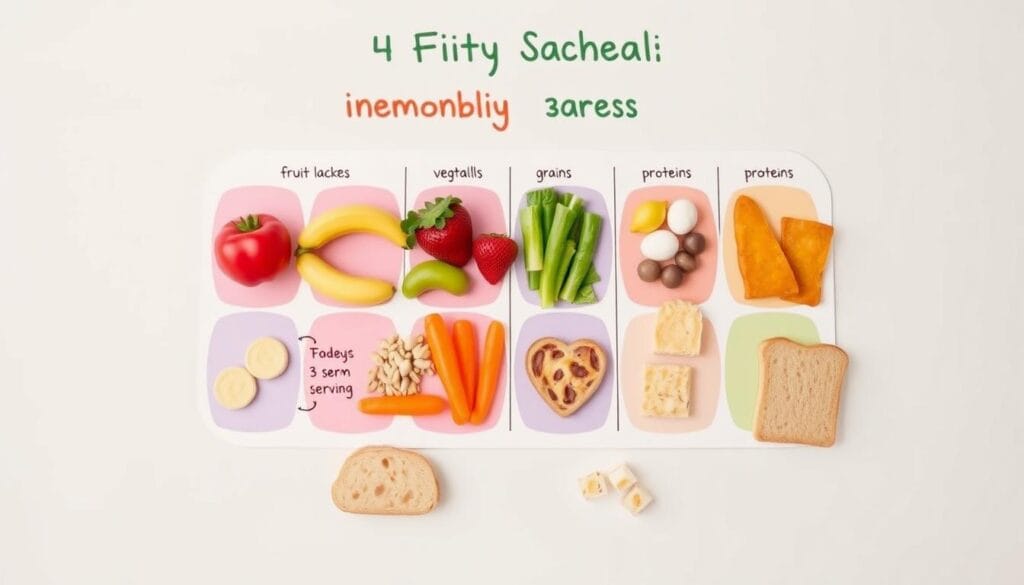A 10-month-old baby’s diet is key for their growth and health. They need a mix of solid foods, breast milk or formula, and water. The American Academy of Pediatrics says a balanced diet is essential for a 10-month-old baby, including fruits, vegetables, grains, and proteins to meet their nutritional needs and support their overall development. Balanced Diet for 10-Month-Old Baby, 10-Month-Old Baby Nutrition, Healthy Baby Food Plan
At this age, babies should eat a variety of foods. This includes fruits, vegetables, proteins, and whole grains. A sample menu might include oatmeal with fruit, scrambled eggs, and pureed veggies. These foods can be part of a baby’s feeding schedule.

Table of Contents
Understanding Nutritional Needs at 10 Months
At 10 months, babies need a healthy diet for infants that balances breast milk or formula with solid foods for babies. The American Academy of Pediatrics says a 10-month-old needs 750-900 calories daily. About 400-500 calories should come from breast milk or formula. It’s important to start introducing solids to baby at this age for their growth.
A 10-month-old’s daily meals should include breakfast, lunch, snacks, and dinner. These meals should offer a mix of nutrients. Foods rich in iron and zinc, like meats and lentils, are key. Also, foods high in energy, like avocado and sweet potato, are good choices.
- Offer three main meals and two snacks between meals each day
- Provide around two to four ounces of breast milk or formula alongside solid food at meals
- Include a variety of fruits and vegetables in the diet, removing inedible or poisonous parts
- Avoid adding salt, sugar, or honey to a 10-month-old’s food
By knowing what a 10-month-old baby needs, parents can give them a balanced diet. This includes solid foods for babies and breast milk or formula. It’s also important to watch how much food a baby eats and choose foods wisely.
Creating a Balanced Diet for Your 10 Month-Old Baby
Babies at 10 months need a balanced diet with age-appropriate foods for babies. Start with small portions and increase as they show interest. Feeding tips for 10 month-old babies include a variety of foods like whole grains, fruits, vegetables, and proteins.
A feeding guide for 10-month-olds suggests 2 to 3 meals and 1 to 2 snacks a day. Baby meal ideas include oatmeal with fruit, scrambled eggs, and pureed veggies. Make sure they get enough iron from foods like pureed meats and fortified cereals, at least twice a day.
- Offer a variety of foods from different food groups
- Start with small portions and gradually increase the amount
- Include iron-rich foods in the diet, such as pureed meats and fortified cereals
- Avoid giving babies foods that are high in sugar, salt, and unhealthy fats
By following these feeding tips for 10 month-old babies and offering a range of age-appropriate foods for babies, parents can help their baby develop healthy eating habits. This ensures they get the nutrients needed for growth and development. Always check with a healthcare provider before introducing new foods to a baby’s diet.
Essential Food Groups for Infant Development
Introducing a variety of foods is key for baby nutrition. The American Academy of Pediatrics suggests a mix of proteins, fruits, vegetables, whole grains, and dairy. This helps start healthy eating habits early.
A balanced diet with different baby food options is vital for growth. Infant feeding should include breast milk or formula and solid foods. As babies grow, they need various nutrients for development.
Proteins and Iron-Rich Foods
Proteins and iron-rich foods, like eggs and pureed meats, are important. They give essential nutrients for the baby’s health.
Fruits and Vegetables
Fruits and vegetables are full of vitamins and minerals. Whole grains and cereals add fiber and nutrients. Dairy products and alternatives, like breast milk or formula, give calcium and vitamin D.
Whole Grains and Cereals
Whole grains and cereals are packed with fiber and nutrients. They’re great baby food options. You can start with pureed cereals or soft, cooked grains.
Dairy Products and Alternatives
Dairy and alternatives, such as breast milk or formula, are rich in calcium and vitamin D. These are crucial for strong bones and teeth.
| Food Group | Examples | Nutrients |
|---|---|---|
| Proteins | Eggs, pureed meats | Iron, protein |
| Fruits and Vegetables | Apples, carrots | Vitamins, minerals |
| Whole Grains and Cereals | Brown rice, oats | Fiber, nutrients |
| Dairy Products and Alternatives | Breast milk, formula | Calcium, vitamin D |
Establishing a Healthy Feeding Schedule
A healthy feeding schedule is key for a 10-month-old baby’s growth. They need a diet rich in nutrient requirements for infants like proteins, iron, and calcium. Introducing solid foods should be slow, with new foods added one at a time to watch for allergies.
Experts suggest three main meals and two to three snacks daily. Breast milk or formula should still be a big part of their diet. Here’s a sample schedule:
- Breakfast: oatmeal with fruit and breast milk or formula
- Lunch: mashed vegetables and proteins, like chicken or turkey
- Dinner: mashed fruits and whole grains, such as brown rice or quinoa
- Snacks: pureed fruits and vegetables, like apples or carrots
Remember, every baby is unique, and their early childhood nutrition needs can differ. It’s important to talk to a pediatrician to find the right feeding schedule. Also, watch for signs of food allergies and introduce new foods slowly.

By setting up a healthy feeding schedule and keeping an eye on their nutrient requirements for infants, parents can help their child develop good eating habits. This ensures they get the nutrients they need for growth and development.
Safe Food Preparation and Serving Sizes
Feeding a 10-month-old baby safely is very important. The American Academy of Pediatrics says babies should eat soft, mashed, or pureed foods. This helps prevent choking, which is key for their health.
A good feeding schedule for babies includes a variety of textures. Infant nutrition is crucial for their growth. A balanced diet with breast milk or formula and solid foods is best. A 10-month-old baby might have 3-4 main meals and 2-3 snacks in between.
- Start with small portions and gradually increase the amount as the baby becomes more interested.
- Choose foods that are soft, mashed, or pureed to reduce the risk of choking.
- Avoid giving babies small, round, firm, and slippery foods, such as seeds, whole nuts, baby carrots, apples, pomegranate arils, and grapes.
| Food Type | Texture | Serving Size |
|---|---|---|
| Fruits | Soft, mashed, or pureed | 1-2 tablespoons |
| Vegetables | Soft, mashed, or pureed | 1-2 tablespoons |
| Proteins | Finely chopped or pureed | 1-2 tablespoons |
By following these tips, parents can make sure their 10-month-old baby gets the right nutrients. This also helps avoid choking and other safety issues.
Common Feeding Challenges and Solutions
At 10 months old, babies often face common feeding challenges. One big challenge is picky eating, where babies refuse to eat certain nutrient-rich foods. To solve this, parents can offer a variety of foods and encourage self-feeding.
It’s also key to remember that babies might need 10 to 15 tries of a new food before they’ll eat it.
Another challenge is managing food allergies. Parents need to watch for signs of an allergy and introduce new foods one at a time. When starting introducing solids, start with small portion sizes. Then, increase the amount as the baby gets used to eating solids.
It’s also important to watch for developmental milestones. Signs like sitting up and bringing toys to their mouth show the baby is ready for solids.
Here are some tips to help parents overcome common feeding challenges:
- Offer a variety of nutrient-rich foods to ensure the baby is getting all the necessary nutrients.
- Start with small portion sizes and gradually increase the amount as the baby gets used to eating solids.
- Monitor for signs of food allergies and introduce new foods one at a time.
- Encourage self-feeding and offer a variety of foods to promote developmental milestones.
| Age | Food | Portion Size |
|---|---|---|
| 6-8 months | Single grain infant cereal | 1-2 feedings a day |
| 8-12 months | Variety of foods including dairy, cereals, vegetables, fruits, and proteins | 30-32 ounces per day |
Foods to Avoid and Safety Precautions
When it comes to growth and development, it’s key to watch out for foods that can slow down baby development milestones. At 10 months, babies are at risk for choking and allergic reactions. Foods like nuts, popcorn, and common allergens like peanuts and shellfish should be avoided. These can cause choking and severe allergic reactions.
Some of the best foods for baby growth are those packed with nutrients and easy to digest. But, it’s important to introduce these foods carefully to avoid choking and allergic reactions. For instance, whole nuts and peanuts are choking hazards and should not be given to children under 5. Instead, nut butters or finely chopped nuts are safer alternatives.
- Avoid giving salty foods such as bacon, sausages, and crisps to babies
- Limit foods high in saturated fat like crisps and cakes
- Avoid honey consumption until the baby is over 1 year old
- Don’t give whole nuts and peanuts to children under 5 years old
By being careful with these foods and taking safety steps, parents can help their baby grow well. Always watch over mealtime and make sure the baby is sitting up straight to avoid choking. With the right foods and safety measures, parents can help their baby reach baby development milestones and develop healthy eating habits for life.
| Foods to Avoid | Reason |
|---|---|
| Nuts and popcorn | Choking hazards |
| Peanuts and shellfish | Common allergens |
| Salty foods | Adverse effects on kidneys |
| Foods high in saturated fat | Contribute to unhealthy eating habits |
Monitoring Growth and Development Milestones
As a parent, it’s key to watch your 10-month-old baby’s growth and milestones. This means tracking their weight, seeing if they’re ready for new foods, and talking to doctors when needed. A feeding schedule for 10 month-old baby should mix different foods for a balanced diet.
Kids Nutrition says a 10-month-old baby needs 24 to 32 ounces of milk daily. Make sure their calories come from good sources like fruits, veggies, and fortified cereals. Baby feeding is important, focusing on a variety of foods to help them eat well.

- Weight gain: average weight for a 10-month-old baby boy is 20 pounds 5 ounces, and for a baby girl, it’s 18 pounds 12 ounces
- Length: average length for a 10-month-old baby boy is 29 inches, and for a baby girl, it’s 28 1/4 inches
- Developmental signs: babies at this age may start standing by pulling themselves up, exploring toys differently, and imitating words and gestures
Doctors usually suggest six to seven visits in a baby’s first year to check growth. By watching these milestones and keeping a balanced feeding schedule for 10 month-old baby, parents help their baby grow well. This also encourages healthy eating for infants and nutrient-rich foods for babies.
Building Lifelong Healthy Eating Habits
It’s important for a 10-month-old to have a balanced diet and a good relationship with food. Parents can start by giving them pureed fruits and veggies. This ensures they get the nutrients they need during this time.
Homemade baby food, like soups and purees, is a great choice for busy parents. It’s healthy and easy to make.
Introducing a variety of foods, including proteins, grains, dairy, and lots of fruits and veggies, is key. It helps build healthy eating habits for life. It might take a few tries for a baby to like new tastes and textures.
But with patience and the right guidance, parents can help their 10-month-old develop a positive food relationship. This will benefit them for many years.
FAQ
What are the key nutrients a 10-month-old baby needs for growth and development?
A 10-month-old baby needs protein, iron, and zinc for growth and development.
What are the caloric requirements for a 10-month-old baby?
A 10-month-old baby needs 750-900 calories a day. About 400-500 calories should come from breast milk or formula.
How can I create a balanced diet for my 10-month-old baby?
For a balanced diet, offer a mix of solid foods like fruits, veggies, proteins, and whole grains. Still, give lots of breast milk or formula.
What are the essential food groups for infant development?
Essential food groups include proteins, fruits, veggies, whole grains, and dairy products.
How often should I feed my 10-month-old baby?
Feed your 10-month-old three main meals and two to three snacks daily. Breast milk or formula should still be a big part of their diet.
What are the appropriate textures and serving sizes for a 10-month-old baby?
Foods should be soft, mashed, or pureed to avoid choking. Start with small portions and increase as the baby shows interest.
How can I deal with common feeding challenges, such as picky eating or food allergies?
Be patient and keep offering different foods to help with picky eating. For food allergies, watch for signs and introduce new foods slowly.
What foods should I avoid for my 10-month-old baby?
Avoid foods that are choking hazards, like nuts and popcorn. Also, steer clear of common allergens like peanuts and shellfish.
How can I monitor my 10-month-old baby’s growth and development milestones?
Watch for weight gain and developmental signs. Consult healthcare providers if you have concerns to ensure your baby is healthy.
How can I build lifelong healthy eating habits for my 10-month-old baby?
Offer a balanced diet with fruits, veggies, whole grains, and lean proteins. Encourage self-feeding and use age-appropriate recipes.
